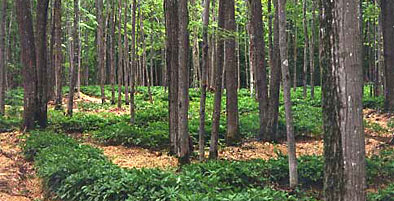Nutrient losses from a single removal of pine straw are small and not likely to affect stand productivity. Research indicates, however, that frequent raking can result in significant nutrient losses. Nutrient-deficient stands produce less wood and foliage, and, consequently, less pine straw, than stands with adequate nutrition. Studies show that harvesting pine straw reduces wood production by an average of 50 cubic feet (1.42m³ ) per acre if nutrients in the straw are not offset by fertilization. Commercial fertilizer applications can replenish nutrients as well as increase pine straw production.
Pine straw is an integral component in promoting forest health. Straw contains nitrogen, phosphorus, calcium, and magnesium that return to the soil as the straw breaks down. Harvesting straw removes these nutrients. For every 100 bales of straw collected as much as 40 lb of nitrogen is lost. This loss of nitrogen will increase the time between tree rotations. These trees will be weaker and more susceptible to insect and disease.
Decaying pine straw on the forest floor works as mulch and holds in water and insulates the soil from excessive heat. Both water stress and extreme heat can stunt the growth of trees. Removing pine straw removes the soil’s organic matter (O) horizon of partial decomposed matter that helps prevent soil erosion and soil compaction. Removing straw can also disrupt the local wildlife. Pine needles provide food and habitat for animals and plants that speed the decomposition process. Harvesting straw removes undecomposed matter that, over time, will alter soil chemistry, transforming an acidic soil into a more neutral (alkaline) pH soil. Because of these effects of disturbance, some harvesting is done in such a way to leave a couple of inches of straw and/or to resupply with compost to the soil surface. Remember, fertilizer application can replenish nutrients as well as increase pine straw production for more sustainable harvests.
References:
